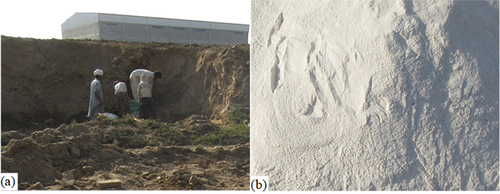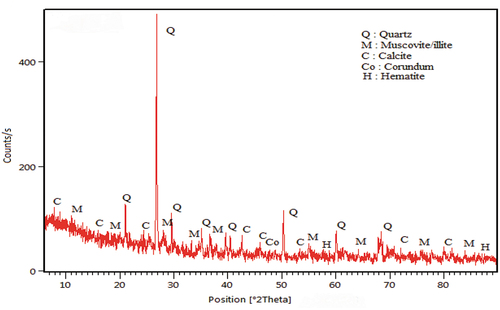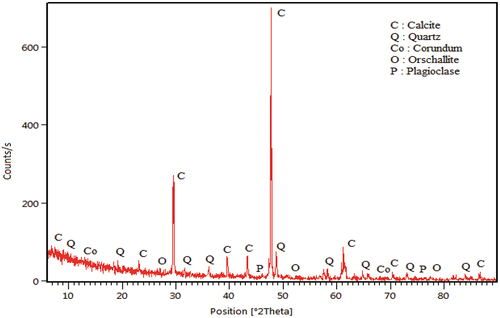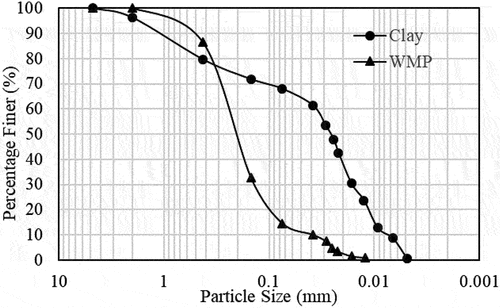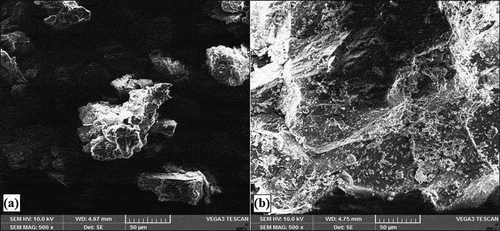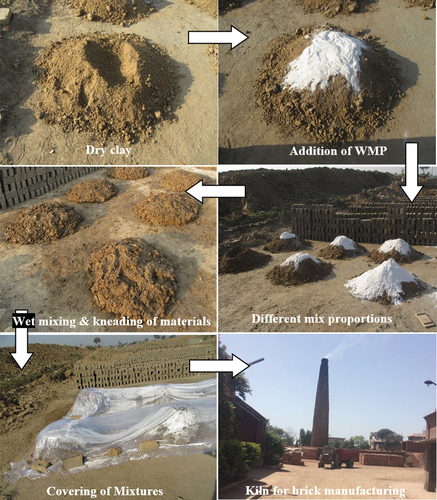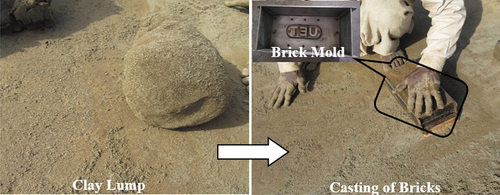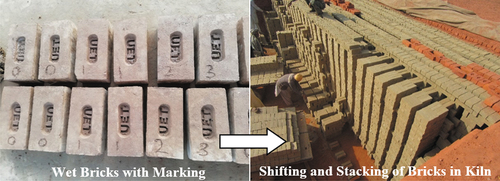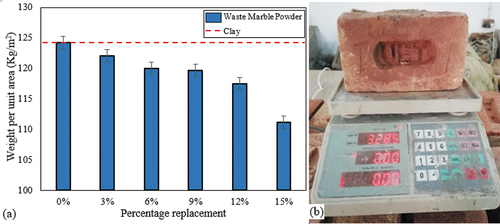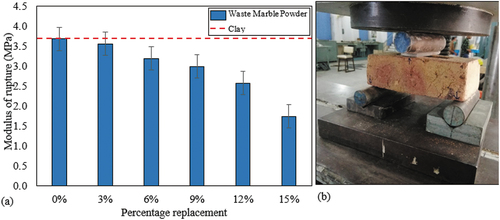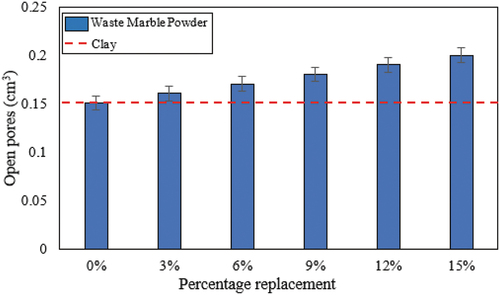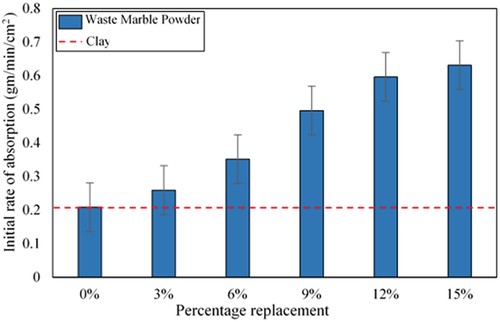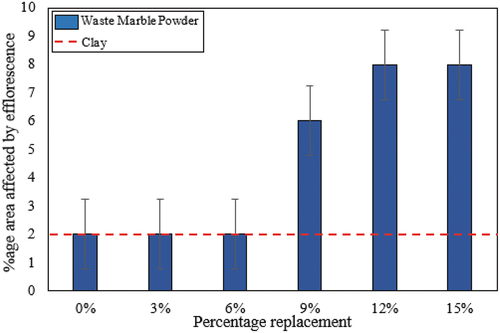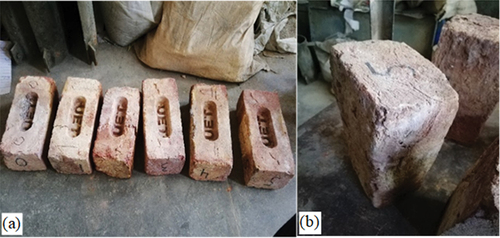ABSTRACT
Burnt clay brick is one of the oldest and most widely used construction materials. The production of burnt clay bricks with various waste materials can help reduce the environmental hazards and improve brick performance at low manufacturing costs, thereby leading towards more sustainable construction. This research aimed to evaluate the effect of using waste marble powder (WMP) in varying percentages, i.e., 0, 3, 6, 9, 12, and 15%, by weight of clay in an industrial brick kiln plant. A range of mechanical and durability tests was performed on the raw material, i.e., clay, WMP, and bricks, to quantify their performance. It was observed that incorporation of WMP resulted in a reduced unit weight of the bricks, making the structure lighter in weight. Moreover, compressive strength and freeze thaw test results for all the brick specimens and sulfate tests for the brick specimens with 12% WMP addition were within the Building Code of Pakistan, and ASTM C67 prescribed limits. Finally, it can be concluded that WMP up to 12% by weight of clay can be incorporated to prepare burnt clay bricks, which can reduce the environmental waste to achieve sustainability and economy for the brick industry.
1. Introduction
Burnt clay bricks are one of the ancient and common materials used in the construction industry. The widespread consumption of the naturally occurring clay deposits for brick making has triggered the alarming level discrepancy of this natural material (Zhang Citation2013). Consequently, the scenario has drawn the attention of many researchers to move their emphasis towards finding or developing new resources and recycling the wastes produced as a result of various industrial processes. For this reason, numerous wastes like sawdust (Emmanuel Citation2008), waste glass powder (Demir Citation2009), rice husk ash (Sutas, Mana, and Pitak Citation2012), sugarcane bagasse ash (James and Pandian Citation2017), fly ash (Murugesan et al. Citation2017), sludge of water treatment plant (Heniegal et al. Citation2020) and waste marble powder (Sutcu et al. Citation2015) have been used in the manufacturing of bricks. Additives must possess physical and chemical characteristics to transform the performance of clay within the specified range and should not cause any harmful impact on the strength and durability performance of the clay (Christy and Tensing Citation2011). Fly ash is a common additive used in clays and produced by burning coal in coal-fired power plants. It is a heterogeneous material composed of iron oxides (hematite and magnetite) and mullite (alumina and silica) and has a lustrous appearance. It has almost the same chemical composition as found in brick soils. The incorporation of fly ash in clay can improve the strength of bricks and lessens the absorption of water (Shakir, Naganathan, and Mustapha Citation2013). Abbas et al. (Citation2017) reported that fly ash bricks are not only environment friendly but also considered as a greener building material (Abbas et al. Citation2017). Rice crop is one of the major source of food for people around the globe and it covers approximately 1% surface of the earth (Memon, Shaikh, and Akbar Citation2011). After combustion of rice husk, different percentage of ash is obtained ranging from 15–25% of total rice husk (Jongpradist et al. Citation2018). A study performed by (Ramasamy Citation2012) showed that usage of a small quantity of rice husk ash improves the compressive strength of the material. Waste glass in powdered form can also be used as an additive in clay bricks. Kazmi et al. (Citation2017) showed increased compressive strength and lowering of cold water absorption, boiling water absorption, initial absorption rate, absorption coefficient, porosity, and pore volume. However, increased shrinkage value has been reported by Djangang et al. (Citation2014). The residue left after extraction of juice from sugarcane is called bagasse which on burning gives ash. Silicon and aluminum oxides are the main components of sugarcane bagasse ash. Madurwar, Mandavgane, and Ralegaonkar (Citation2015) performed the feasibility analysis and concluded that lightweight bricks produced using bagasse ash are recommended in earthquake prone areas. In terms of environmental protection, it gives positive effects in clay bricks; however, strength decreases when used more than 10% of clay weight (Faria, Gurgel, and Holanda Citation2012; Lima et al. Citation2012). Niroumand, Zain, and Alhosseini (Citation2013) reported that nano clays tend to increase the compressive strength of bricks up to four times; however, further research is required in terms of their durability performance. Furthermore, nano clay for brick production is not an economical choice as special procedures are required to obtain nano clays. Eliche-Quesada et al. (Citation2012) studied sawdust recycling, spent earth from oil filtration, compost, and marble residues for brick manufacturing. An increase in water absorption and apparent porosity values in ceramic bricks was observed by incorporating these residues. But at higher temperatures (sintering process) due to liquid phase formation, reduction in porosity and water absorption with enhancement in compressive strength results was observed; hence a lesser percentage of such additive (5%–10) is recommended. Marble stone, a metamorphic rock (non-foliated) and a mineral composition of carbonate crystal of mostly calcite (lime stone) or dolomite, has a wide range of usage in construction industry, generally, as ornamental tiles and other decorative purposes. A large amount of marble turns into waste during cutting and extracting that become one of the most environment endangering productions as it is composed of oxides of calcium, silicon, magnesium, aluminum, potassium, sodium, iron oxides (Uygunotlu, Topçu, and Çelik Citation2014). This waste has caused severe environmental issues like air pollution, surface water contamination, affecting the fertility of natural soil. Dhanapandians and Gnanavel (Citation2009) observed an increased water absorption with up to 20% waste marble powder. Incorporation of waste marble rejects up to 30% in clay mixture lowers down the firing temperature without major compromise on the brick properties, thus, results in energy and cost savings (Segadães, Carvalho, and Acchar Citation2005). The addition of granite and marble waste imparted physical strength to the bricks at high temperature. Especially bulk density, compressive strength and flexural strength was found to be increased due to fluxing action of these wastes at higher temperatures. Usually, 15–20% marble powder replacement is considered the best ratio for up to 850°C temperature. For temperatures beyond 950°C, higher proportion of waste marble powder can be utilized without loss of quality in some aspects. But water absorption is higher as per civil construction criteria (Saboya, Xavier, and Alexandre Citation2007). On contrary, in study by Sutcu et al. (Citation2015), compressive strength was found to be decreased with addition of waste marble powder in bricks but sufficient to use in structural utilization. The past researches showed that the waste marble powder obtained from marble cutting and processing factories can be economically utilized in clay bricks and in other applications such as ground improvement (Qureshi et al. Citation2018). To economize the construction materials without quality compromising, potential utilization of natural wastes, that are inexpensively available, is becoming ever demanding. Furthermore, very scarce research is available on endurance performance i.e. efflorescence, freeze-thaw, porosity, sulfate attack, ultrasonic pulse velocity etc. of bricks incorporating waste marble powder.
Based on this, the overall purpose of this research is to examine the behavior of burnt clay bricks prepared by adding waste marble powder (WMP) in different proportions, i.e., 0, 3, 6, 9, 12, and 15% by weight of clay. Tests performed to study the physical properties of raw material are chemical analysis, x-ray diffraction, particle size distribution, and SEM. Compressive strength and modulus of rupture tests were performed to study the mechanical behavior. The durability was studied by performing the tests to elucidate apparent porosity, water absorption, the initial water absorption rate, efflorescence, freeze and thaw, sulfate, and ultrasonic pulse velocity. Finally, endurance performance of modified bricks (incorporating different proportions of WMP) was observed, and its comparison with control bricks (clay only) was studied and discussed. All the brick specimens investigated were produced on a large scale at an industrial brick kiln.
2. Materials and methods
2.1. Materials
The natural clay used was obtained by excavation from the pits in the surroundings of the kiln located at Multan Road, Lahore, Pakistan. The WMP used as an additive with clay was obtained without grinding or sieving from a marble processing factory located at Ferozepur Road, Lahore, Pakistan. The natural clay sampling and WMP used in the study are shown in . Brick specimens incorporating 0%, 3, 6, 9, 12, and 15% of waste marble powder were prepared, as shown in . A total of 300 specimens were prepared with 50 specimens for the respective proportion of replacement.
Table 1. Specimen ID and number of brick specimens prepared.
2.2. Mixing and specimen preparation procedure
After weighing both dry clay and waste marble powder in specified ratios as described in , heaps of materials were formed, and manual mixing was carried out with the required tools and labor. After thorough mixing, water was added to the mixture to achieve the required consistency of the mix to make it workable before molding. It was observed that to achieve the same consistency level of the mix, water requirement increased as the contents of waste marble powder increased. After the addition of water, manual kneading was carried out on all the mixtures. With subsequent dry and wet mixing, all mixtures were left covered for about 24 hours to allow the water to fill the voids and attain a homogeneous mix without loss of water content. The procedure of mixture preparation is shown in .
After keeping the mix moistened and covered for 24 hours, a portion of the mixture, i.e., the amount required for casting one brick, was taken in the shape of a clay ball and was hand kneaded well before putting it into the brick mold. The mixture was rolled over dry sand to prevent the clay from sticking to the mold and avoid early cracking in the clay bricks on drying. The prepared mixture was then placed and hand-pressed into molds, and the bricks with dimensions of 9” x 4.5” x 3” were cast, as shown in .
To avoid mixing of specimens, marking on the wet bricks was carried out by engraving relevant numbers assigned to the percentage addition of the WMP. After completing the marking, wet brick specimens were allowed to open-air drying for a duration till they become dry and hard enough to be picked and handled. In dry weather conditions, usually 1 to 2 days are required for drying. But in the present study, the wet brick specimens were dried under shelter to provide rain protection, which took 8 days. Throughout the drying period, bricks were kept flipping, over and over, for complete drying. After drying, specimens were shifted to the kiln on carts and stacked. The process of marking, shifting, and stacking bricks in the kiln is shown in .
Firing or burning is the last stage of preparation of burnt clay bricks. First, bricks were stacked cage-like in the kiln with open spaces between them for fire movement. Then, the firing was initiated using coal fuel, and specimens were fired up to a temperature range of approximately 900°C to 1000°C. The temperature was monitored by using a thermocouple and was approximately around 912°C. Bricks acquired strength, hardness, and color after burning in the kiln and were removed from the kiln after 30 days. All brick specimens were then transported to the laboratory for testing. The process of burning bricks in a kiln and temperature measurement is shown in .
3. Experimental results
3.1. Tests performed on raw materials and their properties
The chemical composition of both materials was determined by chemical analysis (wet method) and X-ray diffraction analysis (XRD). Whereas physical properties were determined by conducting several tests like particle size distribution (ASTM D422 Citation2007), SEM, and specific gravity test (ASTM D854 Citation2014). The details are given in the proceeding section,
3.1.1. Chemical analysis (wet method) and XRD of clay and WMP
The chemical composition of clay and WMP used as materials in this research is shown in . As per the results obtained, clay was observed to have silica (SiO2 81.3%) as a significant fraction along with oxides of aluminum (Al2O3 5.43%), iron (Fe2O3 3.18%), calcium (CaO 2.68%), potassium (K2O 1.92%) and magnesium (MgO 1.22%). WMP was rich in CaO (43.89%) and SiO2 (12.17%) whereas, other oxides of aluminum, magnesium, sulfur, iron, potassium, and sodium were also present in minor quantities. For both clay and WMP, loss on ignition (LOI) at the temperature of 1000°C was 2.15% and 37.69%, respectively. LOI was more for WMP as compared to clay due to the presence of higher organic content. Higher LOI in WMP was mainly due to the emission of CO2 when the conversion of CaCO3 into CaO and CO2 took place at higher temperatures (Saboya, Xavier, and Alexandre Citation2007). LOI is generally related to the porosity of bricks and identifies their mass loss due to the decomposition of carbonates, combustion of organic matter, dehydroxylation reactions, and water evaporation (Aouba et al. Citation2016).
Table 2. Chemical analysis of raw materials of brick specimens.
The x-ray diffraction (XRD) was performed on clay and WMP, and scans were recorded as shown in , respectively. As indicated by the X-ray diffraction pattern, clay mainly consisted of quartz (SiO2), calcite (CaCO3), hematite (Fe2O3), and alumina (Al2O3) with traces of cinnabar (Cr2O3), fluorite (CaF2), and halite (NaCl). The WMP was comprised of calcite (CaCO3), dolomite, and quartz (SiO2) together with traces of orschallite (SO3), mica, potash feldspar, and plagioclase. These crystalline phases of minerals, identified by XRD patterns, were similar to those stated in previous studies (Faria, Gurgel, and Holanda Citation2012).
3.1.2. Particle size distribution and SEM of clay and WMP
shows the particle size distribution curves of both clay and WMP established using (ASTM D422 Citation2007). The main constituents of clay were found to be 3.74% coarse, 16.63% medium, 11.6% fine sand, and 68% silts which shows that clay majorly consists of silt particles. In WMP, 85.38% of particles were of sand, and 14.62% were of silt size. During the firing or burning process, the strength development of burnt clay bricks was also influenced by the particle size distribution of used clay that consequently influenced bricks’ durability (Ahmadi and Reisi Citation2019). shows the photomicrographs of clay and WMP, which are taken from the scanning electron microscope. It can be observed that both clay and WMP had irregularly shaped particles. Similar observations were reported in the study by (Jain and Jha Citation2020). The size of clay particles was smaller than 10 µm, while particles of WMP were clustered together with a size greater than 50 µm. Particles having a wide range of sizes were present in conformance with the particle size distribution.
3.1.3. Specific gravity of clay and WMP
It was noted that the value of specific gravity in the case of WMP was a little bit higher than clay. The value of specific gravity for WMP was found to be 2.74, while in clay, it was found to be 2.68.
3.2. Mechanical properties of brick specimens
Brick specimens were dried for 24 h in an oven at 110°C to determine unit weight according to (ASTM C67 Citation2020). The compressive strength test on brick specimens was performed following the guidelines of (ASTM C67 Citation2020). All tested brick specimens were subjected to a compressive load at the rate of 1.25 mm/min. The flexural strength of brick specimens was determined following (ASTM C67 Citation2020) at a 1.27 mm/min loading rate. The details are given in the proceeding section.
3.2.1. Weight per unit area and apparent specific gravity
Weight per unit area of brick incorporating WMP was carried out according to the (ASTM C67 Citation2020) using an electronic weighing balance, and the results are shown in . The results show that the weight per unit area of brick decreases by increasing the percentage of WMP from 0% to 15%. The bricks with 0% WPM showed a higher weight per unit area than the bricks prepared with 15% WMP. The incorporation of 15% WMP by weight of clay resulted in a weight reduction of 10.52%, making the bricks lighter in weight. The decrease in unit weight may be due to the decomposition of carbonates on combustion in bricks with high WMP content. Previous studies showed similar results, i.e., lightweight bricks obtained by incorporating waste marble powder (Tonnayopas, Tekasakul, and Jaritgnam Citation2008). Lighter weight reduces the transportation and labor cost while reducing structural load and flexibility in architectural design can be achieved. shows the values of specific gravity of the brick specimens. It can be seen that the specific gravity decreased as the waste marble powder percentage was increased. For control specimens, the average value of specific gravity was 2.30, whereas, specific gravity for bricks with 15% WMP addition was 2.11
3.2.2. Compressive strength
For each percentage of WMP addition, five brick specimens were tested. ) shows the average compressive strength of brick specimens with a coefficient of variation (COV) of less than 7%. A declining trend was observed in compressive strength values with the addition of WMP. In , the control specimens achieved higher compressive strength values, i.e., 15.66 MPa. At the 3% addition of WMP in bricks, a reduction of 3.63% in compressing strength was observed, whereas 15% of WMP addition further reduced that value by 41%. The distribution of pore size, porosity, and burnt clay bricks’ density primarily influence compressive strength (Aouba et al. Citation2016). Previous investigations also described similar results, with an inverse relationship between apparent porosity and compressive strength of bricks (Eliche-Quesada et al. Citation2012). The bricks with WMP addition have higher quantities of carbonates, the burning results in porous structure and reduced compressive strength (Kazmi et al. Citation2016).
Furthermore, with the addition of WMP in high dosages, the mixture’s homogeneity was adversely affected, which might cause a reduction in the compressive strength, as reported previously by Sutcu et al. (Citation2015). As per the Building Code of Pakistan, burnt clay bricks should have a minimum compressive strength of 8.25 MPa (BCP-07 Citation2007). From the results, it can be concluded that clay can be efficiently replaced up to 15% by WMP for economical and eco-friendly brick production. All bricks, including specimens with 15% WMP, attained the compressive strength conforming to the minimum criteria of the Building Code of Pakistan, and thus, can be used effectively in sustainable and low-cost masonry construction. A linear relationship between the apparent porosity and compressive strength of brick specimens was observed, as portrayed in . As expected, reduced porosity resulted in higher compressive strength of brick specimens. Similar results were reported in a previous study by Bilgin et al. (Citation2012).
3.2.3. Flexural strength
Arrangement and flexural strength results incorporating WMP are shown in ). Five bricks specimens were tested for each percentage incorporation of WMP, average values of modulus of rupture were obtained, and coefficient of variation (COV) was calculated to be less than 10%. It was found that specimens with 0% WMP had a higher value of flexural strength. As the added quantity of WMP was increased, a decreasing trend was obtained for the flexural strength values. The control specimens showed the highest flexural strength of 3.67 MPa. Flexural strength obtained with 3% WMP addition was 3.55 MPa, which was 4.5% less than the control specimen. The lowest flexural strength value of 1.74 MPa was observed for specimens with 15% WMP addition, with a significant reduction of approximately 50%. The decreasing trend obtained in flexural strength values for WMP incorporation was consistent with the previous studies. Higher percentages of WMP in clay bricks induce porosity that adversely affects the microstructure of bricks, hence, decreasing the flexural strength (Bilgin et al. Citation2012). For masonry use of bricks in construction, a flexural strength of 0.65 MPa is the minimum permissible limit (Niroumand, Zain, and Alhosseini Citation2013; ASTM C67 Citation2020). The range of average flexural strength values for all the tested bricks was from 3.67 MPa to 1.74 MPa. Hence, industrial-scale production of bricks with WMP can be carried out efficiently for sustainable and cost-effective construction.
3.3. Durability properties of brick specimens
Durability was studied by performing apparent porosity (ASTM C20 Citation2015), water absorption (ASTM C67 Citation2020), the initial rate of water absorption (ASTM C67 Citation2020), efflorescence (ASTM C67 Citation2020), freeze and thaw (ASTM C67 Citation2020), sulfate (ASTM C1012 Citation2018), and ultrasonic pulse velocity (ASTM C597 Citation2016) tests. The details are given in the proceeding section,
3.3.1. Apparent porosity
Brick samples for measuring porosity, arrangement for porosity test, and results are shown in . An increasing trend was observed as the quantity of WMP was increased from 0% to 15%. The least porosity was shown by the control specimens (i.e., 21.45%), while specimens with 15% WMP were observed to have a higher porosity value (i.e., 33%). The results obtained from this study are consistent with the study reported by (Eliche-Quesada et al. Citation2012). The main reason for increased porosity can be attributed to the higher LOI value of WMP, resulting from the decomposition of calcium carbonates (CaCO3) into CaO and CO2 and combustion of residual biomass due to which size and amount of pores increased (Aouba et al. Citation2016; Eliche-Quesada and Leite-Costa Citation2016). The emission of CO2 and the expandable nature of CaO material leads to the increased porosity. The produced CaO, a very reactive compound (Sutcu and Akkurt Citation2009), also contributes to modifying the brick properties. It can transform the quartz phase of bricks to modified phases, like calcium alumino-silicates (Sutcu et al. Citation2015). The capacity of bricks to absorb water also increased as the porosity of bricks increased. Improved insulation properties and lightweight bricks are the advantages of high porosity in bricks as long as their mechanical properties satisfy the minimum requirements as per building codes (Madurwar, Mandavgane, and Ralegaonkar Citation2015). Thus, bricks with added WMP can be employed where enhanced insulation and resistance against heat transfer are mandatory.
3.3.2. Water absorption
One of the factors affecting the durability of the bricks is water absorption. ) shows the results for the test of water absorption performed on the bricks. A higher rate of water absorption was observed as the percentage of WMP was increased. The average water absorption value for the control bricks (0% WMP) observed was 8.81%, whereas, for the maximum waste marble powder replacement (15% WMP), the value of water absorption increased up to 21%. Although, as stated already, the porosity of the bricks was increased by increasing the percentage of WMP, the water absorption values observed for a higher percentage of waste marble powder addition were higher than the control bricks. ) shows a linear relation between porosity and water absorption. Previous studies showed similar observations (Faria, Gurgel, and Holanda Citation2012). Therefore, the trend shown by water absorption test results was inconsistent with the bricks’ porosity values. As stated in (ASTM C62 Citation2017), the limiting values of water absorption for bricks are 17% and 22% for severe and moderate weather-resistant conditions, respectively. Likewise, past studies have mentioned a range of 20–30% as the maximum water absorption value for bricks (Saboya, Xavier, and Alexandre Citation2007; Phonphuak Citation2013). ) shows that the maximum average water absorption value observed was 21% for 15% WMP replacement. Therefore, all the bricks satisfied the water absorption limit criteria for moderate weather-resistant conditions. In contrast, bricks with up to 12% WMP usage had an average water absorption value of less than 17% and hence can be efficiently used in severe weather conditions. As a result, it can be concluded that bricks with WMP addition of 12% and 15% by weight of clay can be used efficiently for severe and moderate weather conditions, consequently making the bricks durable and low cost.
3.3.3. Initial rate of water absorption
The results for the initial rate of absorption for the bricks incorporating WMP are shown in . An increased initial absorption rate of bricks was observed with an increase in the percentage of WMP from 0% to 15%. The value of the initial rate of absorption for the bricks with 0% WMP was 0.208 gm/min/cm2, whereas, for the bricks with 15% WMP by weight of clay, the value increased up to 0.631 gm/min/cm2. This increase in the value of the initial absorption rate can be attributed to the higher porosity as the percentage of WMP is increased in the bricks (Banu et al. Citation2013). The limit of initial rate of absorption for the first-class bricks, as described in the (ASTM C62 Citation2017), ranges from 0.025 gm/min/cm2 to 0.15 gm/min/cm2 while in this case it ranged from 0.208 gm/min/cm2 to 0.631 gm/min/cm2. Hence, using properly wetted bricks for the lying to achieve a proper brick-mortar bond is suggested.
3.3.4. Efflorescence
The formation of salt deposits on brick surfaces gives rise to efflorescence, resulting in bad aesthetics to the brick masonry structures (Ukwatta et al. Citation2015). represents the effects of efflorescence testing for burnt clay bricks incorporating WMP. An Increase in efflorescence was observed as the percentage of WMP was increased. The samples were observed after 7 days, and the surface area affected by efflorescence in controlled and 15% WMP added bricks was 2 and 8%, respectively. After 45 days, specimens were examined again to inspect the extent of efflorescence over a more extended period (). After 45 days, control specimens showed efflorescence of 9%, and in the case of 15%, WMP added bricks was 18% of the total surface area. The presence of calcium oxide (CaO) contributes primarily to causing efflorescence (Netinger et al. Citation2014). The clay used in bricks had 2.68% of CaO while, waste marble powder had approximately 43.89% of CaO. Therefore, after incorporating WMP in clay, the percentage of CaO was increased, which results in increased efflorescence. In addition to CaO, ferric oxide (Fe2O3) is also a potential cause of efflorescence in bricks, and usually, less than 10% of Fe2O3 is generally suggested (Muñoz Velasco et al. Citation2014). The amount of Fe2O3 present in clay was 3.18%, due to which there was a low extent of efflorescence in control bricks. Comparatively, in WMP, Fe2O3 percentage was found to be less (i.e., 0.21%). So, a high amount of CaO was the leading cause of efflorescence due to the increased amount of WMP in bricks. Similar findings were stated in earlier studies (Madurwar, Mandavgane, and Ralegaonkar Citation2015; Hegazy, Fouad, and Hassanain Citation2012). Bricks having up to 6% of WMP content showed similar efflorescence as the control brick specimens.
3.3.5. Freeze-thaw test
The durability of burnt clay brick against freeze-thaw is mainly governed by the climatic factor and its interaction with the used materials (Mallidi Citation1996). When bricks are subjected to freeze-thaw cycles, water within the pores freezes and expands in volume. As the water freezes in the pores of geomaterial, its volume increases by approximately 9% (Seaverson et al. Citation2002). It induces stresses, excessive enough to fail the large jointed rock masses in the field (Qureshi et al. Citation2009). The expansion of water within the pores generates pressure that may cause damage if the volume of expanding water is more than the pore volume (Chidiac and Federico Citation2007). Qureshi, Towhata, and Yamada (Citation2019) reported that the repeated freeze-thaw cycles deteriorate the porous geomaterial, resulting in decreased mechanical. ) show the reduction in the weight of bricks prepared by adding WMP when subjected to freeze-thaw cycles. Results show that approximately 2% loss in weight occurred in the case of control brick specimens. Whereas, for the bricks containing 15% WMP, weight loss observed was about 2.5% after 50 cycles, higher than the control bricks. Generally, the main factor affecting the resistance of bricks against freeze-thaw is its porosity (Davison Citation2010). An increase in the pore volume of the bricks tends to reduce the durability with a higher loss of mass (Netinger et al. Citation2014). As per (ASTM C67 Citation2020), if specimen cracks during freeze-thaw cycles or loss in weight increases by 3%, then the specimen is considered as fail. All the specimens showed no cracks after 50 cycles of freeze-thaw and the condition of bricks during and after freeze and thaw tests can be seen in ). Moreover, observed weight loss was also less than 3% for all specimens. Hence, despite the increase in weight loss with an increasing amount of WMP, all specimens satisfy the (ASTM C67 Citation2020) criteria and can be classified as freeze-thaw resistant.
3.3.6. Sulfate Test
Brick specimens immersed in sulfate solution and the sulfate test results are shown in , which illustrates the reduction in compressive strength and increase in weight. It was observed that the compressive strength of bricks decreased in the sulfate environment while the weight of the bricks was increased. For instance, the strength decrease in the control samples (without WMP) was approximately 8.5%; while, it varied from 10.6 to 18% for bricks (with WMP addition) as the percentage of WMP increased from 3% to 15%. Crystallization of sulfate salts within the pores of bricks produced pressure that caused internal micro cracking, consequently leading to a reduction in compressive strength. Bricks with up to 12% WMP addition indicated average compressive strength of 8.75 MPa (16% reduction compared to bricks without sulfate attack), satisfying the minimum compressive strength criteria as per the Building Code of Pakistan (BCP-07 Citation2007), i.e., 8.25 MPa. ) shows a 6.28% increase in weight for the control specimens, while, for specimens with WMP addition of 3% and 15%, the weight gain was 8.72% and 16%, respectively. An increase in the weight of bricks may be attributed to the partial filling of pores with sulfate crystals. Results obtained were in agreement with previous research by Naik, Bahadure, and Jejurkar (Citation2014), reporting an increase in weight and a decrease in compressive strength under sulfate attack.
3.3.7. Ultrasonic pulse velocity test
Ultrasonic pulse velocity (UPV) test has been long used to evaluate the concrete quality (Naik, Malhotra, and Popovics Citation2003). With this test, concrete flaws and compressive strength can be delineated (Koroth, Paul, and Dorel Citation1998). The results shown in indicate that the increase of WMP content in bricks decreases its UPV. The UPV value for bricks without WMP was 3066 m/s, and it reduced to 2245 m/s for bricks with 15% WMP. Usually, an increase in pulse velocity is related to an increased compressive strength (Koroth Citation1997). UPV test results obtained in all the tested bricks were consistent with the values of compressive strength. As per the study by (Koroth, Paul, and Dorel Citation1998), if the value of UPV is more than 3500 m/s, bricks may be considered durable. If UPV is less than 1000 m/s, bricks may be considered non-durable. Whereas, if the UPV value lies between 1000 to 3500 m/s, it is suggested to carry out UPV tests as per ASTM procedures to evaluate the durability of bricks (Koroth, Paul, and Dorel Citation1998). The UPV values for all the tested bricks ranged from 2000 to 3000 m/sec approximately. So, (ASTM C67 Citation2020) standard procedures may be followed to evaluate bricks’ durability and performance by ASTM standards as well. All the tested brick specimens achieved UPV within the range of 1,600–1,900 m/s. Therefore, the performance of the brick specimens incorporating WGS in this study was evaluated as per (ASTM C67 Citation2020) guidelines.
4. Conclusions
In this research, various properties of burnt clay bricks prepared by incorporating WMP were studied. The utilization of WMP in brick manufacturing can also limit the possible health risks caused by this by-product when left unattended in natural ecosystems. The following conclusions can be established based on the experimental program carried out in this research:
Lightweight bricks can be produced with the addition of WMP. 15% incorporation of WMP as a clay replacement in bricks reduced the weight of bricks up to 10.5%, decreasing the dead load on the structure.
Increasing the proportion of WMP in clay bricks resulted in reduced compressive and flexural strengths. However, despite the decreasing trend in compressive and flexural strength, all the brick specimens (including bricks with 15% WMP) satisfied the required minimum requirements per Pakistan Building Code and ASTM C67.
The porosity of the bricks was increased as the amount of WMP increased, which caused higher water absorption values. Bricks with 12% WMP content, having 16.8% water absorption, can be used as severe weather-resistant bricks. Whereas bricks with up to 15% WMP content, having 21% water absorption, can be used as moderate weather-resistant bricks.
WSP incorporated clay bricks were found resistant against freeze-thaw, and 15% WMP can be incorporated in bricks when subjected to freezing and thawing conditions.
A decrease in compressive strength with an increase in the weight of the bricks was observed when subjected to the sulfate solution. Bricks with 12% WMP addition satisfied the minimum compressive strength requirement as per Pakistan Building Code.
Resistance of the bricks against efflorescence was decreased as the percentage of WMP was increased. In addition, it was noted that the value of ultrasonic pulse velocity was decreased when WMP content was increased in bricks. Ultrasonic pulse velocity for all the tested bricks was in the range of 2000–3000 m/sec.
As per the observations mentioned above and results presented in this study, it can be concluded that WMP up to 12% can be incorporated in clay bricks effectively, leading to its wide-scale application for cost-effective and sustainable construction.
Acknowledgments
Department of Civil Engineering, University of Engineering and Technology, Lahore, Pakistan, is greatly acknowledged for providing the research, financial and experimental facilities. Whereas, experts from National Engineering Services Pakistan (NESPAK), Prince Sultan University, Riyadh, Saudi Arabia, and Sohar University, Oman are greatly acknowledged for providing technical assistance. Authors would like to thank Prince Sultan University for supporting the publication of the manuscript.
Disclosure statement
No potential conflict of interest was reported by the author(s).
Additional information
Notes on contributors
Ali Murtaza Rasool
Dr. Ali Murtaza Rasool has done Ph.D. Civil Engineering and currently working as a Senior Engineer in NESPAK. He has diversified experience of more than 15 years. He is actively involved in research and teaching activities.
Asif Hameed
Dr. Asif Hameed has done Ph.D. Structural Engineering and currently working as Professor at Civil Engineering Department, University of Engineering and Technology Lahore, Pakistan.
Mohsin Usman Qureshi
Dr. Mohsin Usman Qureshi has done Ph.D. Civil Engineering and currently working as Assistant Professor and Head of Research and Development at Sohar University, Oman.
Yasser E. Ibrahim
Dr. Yasser E. Ibrahim has done Ph.D. Structural Engineering and currently working as Professor and Chairman of Engineering Management Department at Prince Sultan University, Riyadh, KSA.
Asad Ullah Qazi
Dr. Asad Ullah Qazi has done Ph.D. Structural Engineering and currently working as Professor and Head Structural Engineering Division, Civil Engineering Department, University of Engineering and Technology Lahore, Pakistan.
Ali Sumair
Mr. Ali Sumair is a graduate student of the Civil Engineering Department, University of Engineering and Technology Lahore, Pakistan.
References
- Abbas, S., M. A. Saleem, S. M. S. Kazmi, and M. J. Munir. 2017. “Production of Sustainable Clay Bricks Using Waste Fly Ash: Mechanical and Durability Properties.” Journal of Building Engineering 14: 7–14. doi:10.1016/j.jobe.2017.09.008.
- Ahmadi, S. F., and M. Reisi. 2019. “Comparison of Mechanical and Durability Properties of Concrete and Fired Facing Bricks.” Proceedings of the Institution of Civil Engineers - Structures and Buildings 173: 512–522. doi:10.1680/jstbu.18.00144.
- Aouba, L., C. Bories, M. Coutand, B. Perrin, and H. Lemercier. 2016. “Properties of Fired Clay Bricks with Incorporated Biomasses: Cases of Olive Stone Flour and Wheat Straw Residues.” Construction and Building Materials 102: 7–13. doi:10.1016/j.conbuildmat.2015.10.040.
- ASTM C1012. 2018. Standard Test Method for Length Change of Hydraulic-Cement Mortars Exposed to a Sulfate Solution. West Conshohocken, Pennsylvania, United States: American Society for Testing and Materials.
- ASTM C20. 2015. Standard Test Methods for Apparent Porosity, Water Absorption, Apparent Specific Gravity, and Bulk Density of Burned Refractory Brick and Shapes by Boiling Water. West Conshohocken, Pennsylvania, United States: American Society for Testing and Materials.
- ASTM C597. 2016. Standard Test Method for Pulse Velocity Through Concrete. West Conshohocken, Pennsylvania, United States: American Society for Testing and Materials.
- ASTM C62. 2017. Standard Specification for Building Brick (Solid Masonry Units Made From Clay or Shale). West Conshohocken, Pennsylvania, United States: American Society for Testing and Materials.
- ASTM C67. 2020. Standard Test Methods for Sampling and Testing Brick and Structural Clay Tile. West Conshohocken, Pennsylvania, United States: American Society for Testing and Materials.
- ASTM D422. 2007. Standard Test Method for Particle-Size Analysis of Soils. West Conshohocken, Pennsylvania, United States: American Society for Testing and Materials.
- ASTM D854. 2014. Standard Test Methods for Specific Gravity of Soil Solids by Water Pycnometer. West Conshohocken, Pennsylvania, United States: American Society for Testing and Materials.
- Banu, T., M. M. Billah, F. Gulshan, and A. S. W. Kurny. 2013. “Experimental Studies on Fly Ash-Sand-Lime Bricks with Gypsum Addition.” American Journal of Materials Engineering and Technology 1: 35–40. doi:10.12691/materials-1-3-2.
- BCP-07. 2007. Building Code of Pakistan - Seismic Provisions-2007. Islamabad, Pakistan: Pakistan Engineering Council.
- Bilgin, N., H. A. Yeprem, S. Arslan, A. Bilgin, E. Günay, and M. Maroglu. 2012. “Use of Waste Marble Powder in Brick Industry.” Construction and Building Materials 29: 449–457. doi:10.1016/j.conbuildmat.2011.10.011.
- Chidiac, S. E., and L. M. Federico. 2007. “Effects of Waste Glass Additions on the Properties and Durability of Fired Clay brickThis Article Is One of a Selection of Papers Published in This Special Issue on Masonry.” Canadian Journal of Civil Engineering 34: 1458–1466. doi:10.1139/L07-120.
- Christy, F., and D. Tensing. 2011. “Greener Building Material with Fly Ash.” Asian Journal of Civil Engineering 12: 87–105.
- Davison, J. 2010. “Linear Expansion Due to Freezing and Other Properties of Bricks.” In 2nd Canadian Masonry Symposium, Ottawa, Canada.
- Demir, I. 2009. “Reuse of Waste Glass in Building Brick Production.” Waste Management & Research 27: 572–577. doi:10.1177/0734242X08096528.
- Dhanapandians, B., and D. Gnanavel. 2009. “An Investigation on the Effect of Incorporation of Granite and Marble Wastes in the Production of Bricks.” Journal of Engineering and Applied Sciences 4: 46–53.
- Djangang, C. N., E. Kamseu, A. Elimbi, G. L. Lecomte, and P. Blanchart. 2014. “Net-Shape Clay Ceramics with Glass Waste Additive.” Materials Sciences and Applications 5 (8): 592–602. doi:10.4236/msa.2014.58061.
- Eliche-Quesada, D., F. A. Corpas-Iglesias, L. Pérez-Villarejo, and F. J. Iglesias-Godino. 2012. “Recycling of Sawdust, Spent Earth from Oil Filtration, Compost and Marble Residues for Brick Manufacturing.” Construction and Building Materials 34: 275–284. doi:10.1016/j.conbuildmat.2012.02.079.
- Eliche-Quesada, D., and J. Leite-Costa. 2016. “Use of Bottom Ash from Olive Pomace Combustion in the Production of Eco-friendly Fired Clay Bricks.” Waste Management (New York, NY) 48: 323–333. doi:10.1016/j.wasman.2015.11.042.
- Emmanuel, O. 2008. “The Effect of Wood Ash and Sawdust Admixtures on the Engineering Properties of a Burnt Laterite-Clay Brick.” Journal of Applied Sciences 8: 1042–1048. doi:10.3923/jas.2008.1042.1048.
- Faria, K. C. P., R. F. Gurgel, and J. N. F. Holanda. 2012. “Recycling of Sugarcane Bagasse Ash Waste in the Production of Clay Bricks.” Journal of Environmental Management 101: 7–12. doi:10.1016/j.jenvman.2012.01.032.
- Hegazy, B. E.-D. E., H. A. Fouad, and A. M. Hassanain. 2012. “Incorporation of Water Sludge, Silica Fume, and Rice Husk Ash in Brick Making.” Advances in Environmental Research 1: 83–96. doi:10.12989/aer.2012.1.1.083.
- Heniegal, A. M., M. A. Ramadan, A. Naguib, and I. S. Agwa. 2020. “Study on Properties of Clay Brick Incorporating Sludge of Water Treatment Plant and Agriculture Waste.” Case Studies in Construction Materials 13: e00397. doi:10.1016/j.cscm.2020.e00397.
- Jain, A. K., and A. K. Jha. 2020. “Geotechnical Behaviour and Micro-analyses of Expansive Soil Amended with Marble Dust.” Soils and Foundations 60: 737–751. doi:10.1016/j.sandf.2020.02.013.
- James, J., and P. K. Pandian. 2017. “A Short Review on the Valorisation of Sugarcane Bagasse Ash in the Manufacture of Stabilized/Sintered Earth Blocks and Tiles.” Advances in Materials Science and Engineering 2017: 1706893. doi:10.1155/2017/1706893.
- Jongpradist, P., W. Homtragoon, R. Sukkarak, W. Kongkitkul, and P. Jamsawang. 2018. “Efficiency of Rice Husk Ash as Cementitious Material in High-Strength Cement-Admixed Clay.” Advances in Civil Engineering 2018: 8346319. doi:10.1155/2018/8346319.
- Kazmi, S. M. S., S. Abbas, M. A. Saleem, M. J. Munir, and A. Khitab. 2016. “Manufacturing of Sustainable Clay Bricks: Utilization of Waste Sugarcane Bagasse and Rice Husk Ashes.” Construction and Building Materials 120: 29–41. doi:10.1016/j.conbuildmat.2016.05.084.
- Kazmi, S., A. Safeer, M. Nehdi, M. Saleem, and M. Munir. 2017. “Feasibility of Using Waste Glass Sludge in Production of Ecofriendly Clay Bricks.” Journal of Materials in Civil Engineering 29: 4017056. doi:10.1061/(ASCE)MT.1943-5533.0001928.
- Koroth, S. 1997. Evaluation and Improvement of Frost Durability of Clay Bricks. Concordia University, Montreal, Quebec, Canada.
- Koroth, S., F. Paul, and F. Dorel. 1998. “Evaluation of Clay Brick Durability Using Ultrasonic Pulse Velocity.” Journal of Architectural Engineering 4: 142–147. doi:10.1061/(ASCE)1076-0431(1998)4:4(142).
- Lima, S. A., H. Varum, A. Sales, and V. F. Neto. 2012. “Analysis of the Mechanical Properties of Compressed Earth Block Masonry Using the Sugarcane Bagasse Ash.” Construction and Building Materials 35: 829–837. doi:10.1016/j.conbuildmat.2012.04.127.
- Madurwar, M., S. Mandavgane, and R. Ralegaonkar. 2015. “Development and Feasibility Analysis of Bagasse Ash Bricks.” Journal of Energy Engineering 141 (3): 4014022. doi:10.1061/(ASCE)EY.1943-7897.0000200.
- Mallidi, S. R. 1996. “Application of Mercury Intrusion Porosimetry on Clay Bricks to Assess Freeze-thaw Durability - A Bibliography with Abstracts.” Construction and Building Materials 10: 461–465. doi:10.1016/0950-0618(96)00005-0.
- Memon, S. A., M. A. Shaikh, and H. Akbar. 2011. “Utilization of Rice Husk Ash as Viscosity Modifying Agent in Self Compacting Concrete.” Construction and Building Materials 25 (2): 1044–1048. doi:10.1016/j.conbuildmat.2010.06.074.
- Muñoz Velasco, P., M. P. Morales Ortíz, M. A. Mendívil Giró, and L. Muñoz Velasco. 2014. “Fired Clay Bricks Manufactured by Adding Wastes as Sustainable Construction Material - A Review.” Construction and Building Materials 63: 97–107. doi:10.1016/j.conbuildmat.2014.03.045.
- Murugesan, T., A. Bahurudeen, M. Sakthivel, R. Vijay, and S. Sakthivel. 2017. “Performance Evaluation of Burnt Clay-Fly Ash Unburnt Bricks and Precast Paver Blocks.” Materials Today: Proceedings. doi:10.1016/j.matpr.2017.06.245.
- Naik, N. S., B. M. Bahadure, and C. L. Jejurkar. 2014. “Strength and Durability of Fly Ash, Cement and Gypsum Bricks.” International Journal of Computational Engineering Research 4: 3–6.
- Naik, T. R., V. M. Malhotra, and J. S. Popovics. 2003. “The Ultrasonic Pulse Velocity Method.” In Handbook on Nondestructive Testing of Concrete. 2nd ed, 1–8. CRC Press.
- Netinger, I., M. Vračević, J. Ranogajec, and S. Vučetić. 2014. “Evaluation of Brick Resistance to Freeze Thaw Cycles according to Indirect Procedures.” Gradjevinar 66: 197–209. doi:10.14256/JCE.956.2013.
- Niroumand, H., M. F. M. Zain, and S. N. Alhosseini. 2013. “The Influence of Nano-clays on Compressive Strength of Earth Bricks as Sustainable Materials.” Procedia - Social and Behavioral Sciences 89: 862–865. doi:10.1016/j.sbspro.2013.08.945.
- Phonphuak, N. 2013. “Effects of Additive on the Physical and Thermal Conductivity of Fired Clay Brick.” Journal of Chemical Science and Technology 2: 95–99.
- Qureshi, M. U., B. Al-Sawafi, M. Al-Washahi, M. Al-Saidi, and S. Al-Badi. 2018. The Sustainable Use of Fine Marble Waste Powder for the Stabilization of Desert Sand in Oman, 303–313. Cham: Springer. doi:10.1007/978-3-319-61612-4_25.
- Qureshi, M. U., I. Towhata, and S. Yamada. 2019. “Experimental Relation between Shear Strength under Low Pressure and S-wave Velocity of Rock Subjected to Mechanical Weathering.” Soils and Foundations 59: 1468–1480. doi:10.1016/j.sandf.2019.06.003.
- Qureshi, M. U., I. Towhata, S. Yamada, M. Aziz, and S. Aoyama. 2009. “Geotechnical Risk Assessment of Highly Weathered Slopes Using Seismic Refraction Technique.” Prediction and Simulation Methods for Geohazard Mitigation 513–518. doi:10.1201/noe0415804820.ch76.
- Ramasamy, V. 2012. “Compressive Strength and Durability Properties of Rice Husk Ash Concrete.” KSCE Journal of Civil Engineering 16 (1): 93–102. doi:10.1007/s12205-012-0779-2.
- Saboya, F., G. C. Xavier, and J. Alexandre. 2007. “The Use of the Powder Marble By-product to Enhance the Properties of Brick Ceramic.” Construction and Building Materials 21 (10): 1950–1960. doi:10.1016/j.conbuildmat.2006.05.029.
- Seaverson, E. J., D. A. Brosnan, J. C. Frederic, and J. P. Sanders. 2002. “Predicting the Freeze-Thaw Durability of Bricks Based on Residual Expansion.” In ASTM STP 1432-D, edited by D. Throop and R. E. Klingner, 122–137. West Conshohocken, PA: ASTM International. doi:10.1520/STP11038S.
- Segadães, A. M., M. A. Carvalho, and W. Acchar. 2005. “Using Marble and Granite Rejects to Enhance the Processing of Clay Products.” Applied Clay Science 30: 42–52. doi:10.1016/j.clay.2005.03.004.
- Shakir, A. A., S. Naganathan, and K. N. Mustapha. 2013. “Properties of Bricks Made Using Fly Ash, Quarry Dust and Billet Scale.” Construction and Building Materials 41: 131–138. doi:10.1016/j.conbuildmat.2012.11.077.
- Sutas, J., A. Mana, and L. Pitak. 2012. “Effect of Rice Husk and Rice Husk Ash to Properties of Bricks.” Procedia Engineering 32: 1061–1067. doi:10.1016/j.proeng.2012.02.055.
- Sutcu, M., and S. Akkurt. 2009. “The Use of Recycled Paper Processing Residues in Making Porous Brick with Reduced Thermal Conductivity.” Ceramics International 35: 2625–2631. doi:10.1016/j.ceramint.2009.02.027.
- Sutcu, M., H. Alptekin, E. Erdogmus, Y. Er, and O. Gencel. 2015. “Characteristics of Fired Clay Bricks with Waste Marble Powder Addition as Building Materials.” Construction and Building Materials 82: 1–8. doi:10.1016/j.conbuildmat.2015.02.055.
- Tonnayopas, D., P. Tekasakul, and S. Jaritgnam. 2008. “Effects of Rice Husk Ash on Characteristics of Lightweight Clay Brick.” In Technology and Innovation for Sustainable Development Conference. Thailand: Khon Kaen, 28–29.
- Ukwatta, A., A. Mohajerani, N. Eshtiaghi, and S. Setunge. 2015. “Variation in Physical and Mechanical Properties of Fired-clay Bricks Incorporating ETP Biosolids.” Journal of Cleaner Production 119: 76–85. doi:10.1016/j.jclepro.2016.01.094.
- Uygunotlu, T., I. B. Topçu, and A. G. Çelik. 2014. “Use of Waste Marble and Recycled Aggregates in Self-compacting Concrete for Environmental Sustainability.” Journal of Cleaner Production 84: 691–700. doi:10.1016/j.jclepro.2014.06.019.
- Zhang, L. 2013. “Production of Bricks from Waste Materials - A Review.” Construction and Building Materials 47: 643–655. doi:10.1016/j.conbuildmat.2013.05.043.

